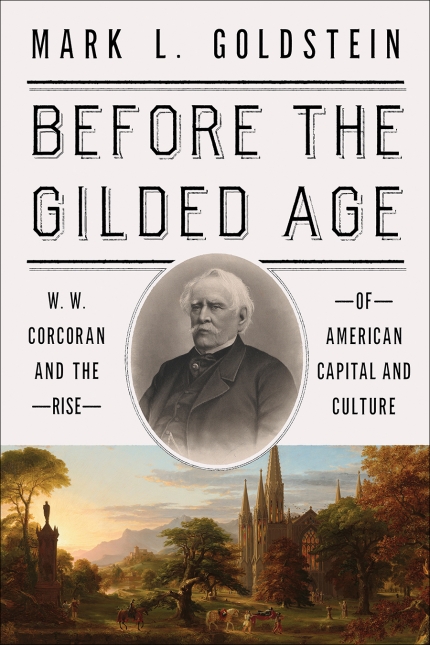Before the Gilded Age: W.W. Corcoran and the Rise of American Capital and Culture
- By Mark L. Goldstein
- Georgetown University Press
- 288 pp.
- Reviewed by John R. Wennersten
- September 7, 2023
Meet the most noteworthy financier you’ve never heard of.

William Wilson Corcoran (1798-1888) was one of the wealthiest bankers and most prominent philanthropists in mid-19th-century Washington, DC. His many financial interests transcended the capital and spread across the nation and into Europe.
In Before the Gilded Age, author Mark L. Goldstein argues that the story of the District native warrants careful attention because Corcoran helped transform the American banking system from a mercantile, familial operation into a behemoth. He came from an Irish merchant family that knew well how to exploit business opportunities and worked his way up in local banking. By the 1830s, he had acquired sufficient influence and capital to found the Riggs Corcoran Bank of Washington (later Riggs Bank).
The geographic expansion of the country, coupled with the numerous possibilities for networking with highly nationalistic leaders like Henry Clay, Daniel Webster, and Presidents Andrew Jackson, John Tyler, and James K. Polk, enabled men fortunate enough to be in the right place at the right time to amass great sums of wealth. Washington was that place for Corcoran. In the antebellum period, the federal government offered endless opportunities to invest in canals, railroads, and the funding of everything from steamship lines to turnpikes.
From his base in Georgetown, Corcoran capitalized on his relationships with figures such as Webster to secure the underwriting of government debt while earning anywhere from 10 to 20 percent commission. It was a time when the nation’s banking structure was becoming increasingly democratized, and even strivers without prominent pedigrees or connections could enter an ever-expanding pool of investment opportunities. As an investor, Corcoran availed himself of these opportunities and took risks where others opted to play it safe. By shrewdly investing federal funds freed up by the dissolution of the Bank of the United States, he won the respect and patronage of the U.S. Treasury. Writes Goldstein:
“Through extensive contacts in Congress and across multiple administrations, Corcoran successfully obtained government deposits and kept treasury funds long after they were withdrawn from other banks.”
In his role as a banker, Corcoran put together blocks of stocks and bonds and was an “aggregator” long before the modern era of hedge funds. He raised capital, purchased securities on credit, redeemed notes, and provided financial intelligence to the Wall Street investors he assiduously cultivated. (Although it is illegal to do so today, Corcoran rose in the financial world by monetizing insider information from Senate connections.)
The author observes that “by the end of the Tyler administration, Corcoran had essentially secured a monopoly on government banking in the capital and tied his firm to some of the most influential banks like Morgan Bank in New York and Barings of London.” His particular genius lay in knowing how to sell a war: He took an entrepreneurial approach to the government’s need for rifles, uniforms, and shoes by leveraging two issues of Mexican War bonds, earning $1 million in commissions in the process.
Thus, Corcoran, on the eve of the Civil War, was one of a few men in America to preside over the reshaping of banking into a broader national enterprise, one that firmly tied Capitol Hill to Wall Street. (Readers interested in the transformation of American capitalism in the 1800s will especially appreciate chapters two and three of Goldstein’s study.)
Though an affable gentleman who loved to entertain and engage in regional philanthropy, Corcoran saw his career take a bad turn during the war. His pride in his Southern lineage and sympathy for secessionists caused him to be accused of disloyalty to the Union, and he was rumored to be involved in an 1862 plot to assassinate Abraham Lincoln. The fact that his daughter was married to the Confederacy’s ambassador to France didn’t help matters, either.
As his social world unraveled, Corcoran took a steamer — with $34 million in gold aboard — to England to sit out the conflict in exile. Fearing the confiscation of his home and property, he lent his estate to the French legation, which put his assets under the cloak of diplomatic immunity.
After the war, Corcoran returned to the U.S. and began to repair his reputation via elegant entertainments, charity, and cultural projects, becoming a leading donor to the completion of the Washington Monument and the beautification of the National Mall. Yet Corcoran, as Goldstein notes in this insightful and meticulously researched biography, has been “largely forgotten in the sweep of history.” If he is recalled at all these days, it’s for DC’s Corcoran Gallery of Art, which he established in the 1870s as America’s first major art museum, “an iconic cultural repository that lasted as an independent institution for 150 years.”
John R. Wennersten is a professor emeritus of American history and a Washington historian currently at work on an environmental history of the District of Columbia.

